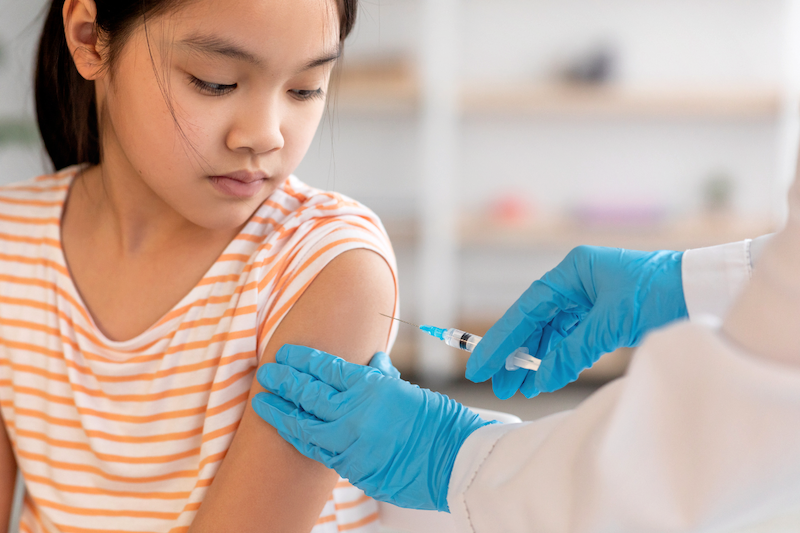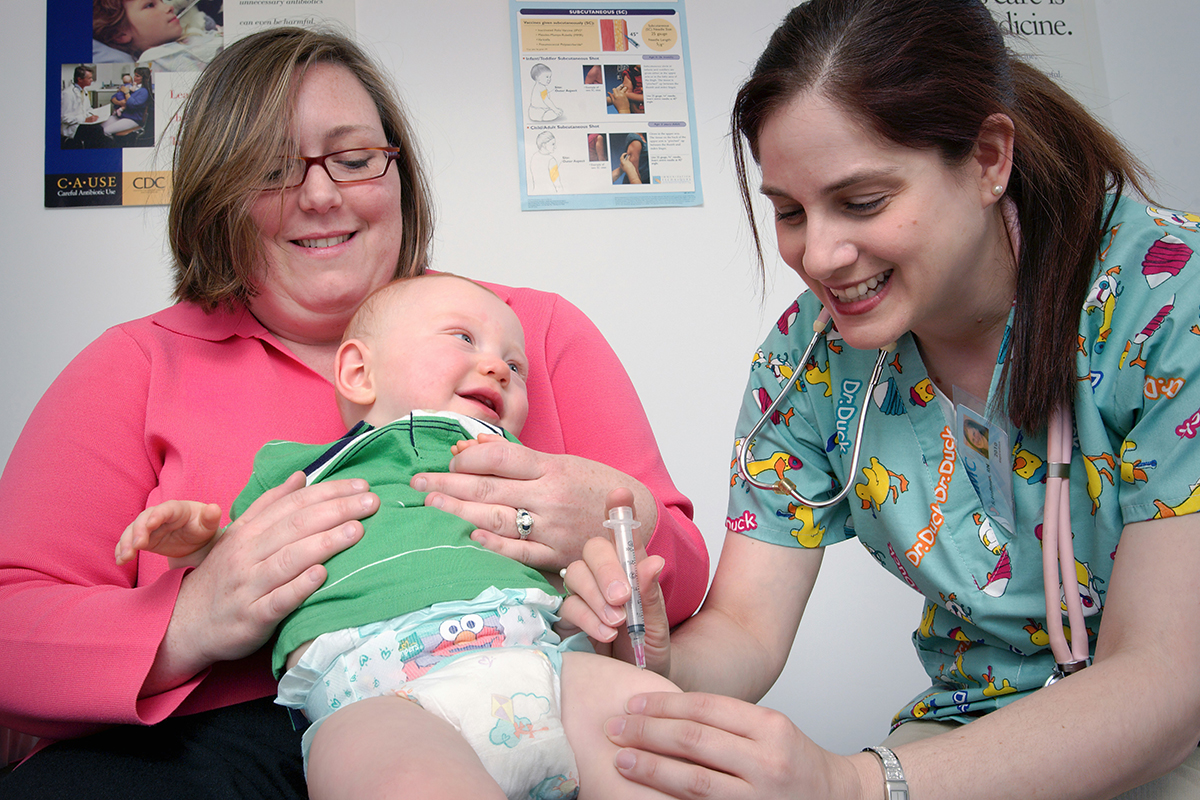We have made this article free for all, in the hopes that people will share it with others who might be interested. If you want to support our work like this, please consider becoming a paid subscriber.
Whenever I write about childhood vaccines, I almost immediately get follow-up questions about vaccine safety. Specifically, concerns that readers hear from their friends and family, incoming government officials, and social media.
Today, the follow-up: an article trying to address the top concerns that I heard from readers, based on your questions, a survey, and recommended books. I settled on six top concerns, not because they were the only questions but because they were the most popular.

A few quick points to start.
First: Much of the rhetoric arguing against vaccination makes claims based on data, and cites studies. In some cases, there are studies — even published in academic journals. But not all data is created equal, and, in many cases, fully understanding what the best data says is crucial.
Second: I want to be up-front and say that I fully vaccinated both of my children and I believe — based on reading the data — that complete childhood vaccination according to the typical schedule is the right choice for virtually all families. However, I also completely understand the instinct to ask questions about our kids, and I think the job of public health should be to meet these with answers. Like all medical treatments, vaccines carry some risk, and being unwilling to discuss that is not productive. My goal with ParentData, here and always, is to try to provide a complete look at the facts so you can make the best choices for your family.
Third: Much of the rhetoric around vaccine safety seems to begin with an underlying assumption that there is a conspiracy with intent to harm, or at least a willingness to harm. Some of this is based on important cultural context — the Tuskegee experiments, for example — which makes it understandable. Whatever the reason is, with this underlying assumption, facts that have innocuous or even quite boring explanations can seem suspicious. A lot of the below is explaining why vaccine systems are set up the way they are. My hope is that with that background, you may see some of these facts in a new light.
Finally: Vaccines are effective at preventing disease. This may seem obvious, but often when this issue is discussed, the assumption seems to be that vaccines have no value. That’s just not true. Over the past 50 years, an estimated 154 million deaths have been prevented by vaccines, and children continue to die globally due to lack of vaccine access.
With that, let’s go. The top 6 vaccine safety concerns, discussed. This is the list, if you want to link directly.
- Vaccines and autism
- Lack of placebo-controlled trials
- There are too many vaccines
- Vaccines contain aluminum
- You can’t sue vaccine makers
- Hepatitis B vaccination at birth
First, how do we know vaccines are safe?
To set the stage, I want to review how vaccine safety is regulated. First, before a vaccine is approved (any vaccine, including newer versions of vaccines for things like measles and pertussis), there are a series of safety and efficacy trials run. These are regulated by the FDA and require companies to pre-register the trials’ existence and report on results. Regulators will then decide, based on those results, whether the vaccine will be approved. Typically, these trials take many years to run.
The trials are designed to be large enough to identify significant side effects, but they may not be large enough to find rare side effects. After approval, there are at least three mechanisms whereby continuing monitoring is used. This includes a database called the VAERS (Vaccine Adverse Event Reporting System), in which individuals and doctors can report suspected adverse events, and the Vaccine Safety Datalink, which is a collaboration among major health-care organizations to monitor health after vaccination. There is also a group of vaccine experts at the CDC who monitor data. And there’s Europe, which has its own Vaccine Monitoring Platform.
At each stage, some vaccines are rejected or pulled. No individual part of this system is perfect, but, combined, it provides a lot of information.
Despite this, there are concerns, which we turn to now.
Concern #1: Vaccines cause autism
Claim: Vaccination is associated with the development of autism.
This is one of the most pervasive and specific claims about vaccine harms. The idea is that something about the vaccine schedule, and perhaps the measles, mumps, and rubella (MMR) vaccine in particular, causes autism. It is true that autism diagnoses have gone up over time, and the reasons for this are not well understood — it seems to be partially about diagnosis but not entirely, and the genetic causes are only beginning to be understood.
However: there is a tremendous amount of evidence to refute the idea that vaccines are responsible for this rise. A 2020 Cochrane Review includes two studies comparing autism rates among vaccinated and unvaccinated children (total sample size: 1.2 million children) and finds no difference in autism rates (the rate is actually slightly lower among vaccinated children). In one of these studies, the authors also show no link when they limit to siblings of children who are diagnosed with autism.
There are other methods to see this. In the U.K., the time trend of autism diagnosis doesn’t align with increases in MMR vaccination rates in the 1980s. In addition, although the U.K. saw a substantial decline in vaccination rates in the early 2000s, autism diagnoses have only increased over time.
I could go on, but I’m not sure it is useful, since for every piece of evidence here, you can find counterarguments. The researchers have CDC funding. The researchers have indicated support for vaccines. These are not randomized trials. These statements are often true, although the implications are usually not. Would it be better to have an infinitely large randomized trial with infinite follow-up so we could definitively prove no association? Of course. But that is both unrealistic and unethical.
Although we will never have perfect data to rule out any possible link, it seems very important to ask, What is the evidence on the other side? What is the reason to think there is an association? The answer is: nothing.
The beginning of this idea — that there is a link between autism and vaccination — is an article by Andrew Wakefield, a doctor in the U.K. He published a case series in The Lancet, arguing based on 12 patients that the MMR vaccine led to autism. This paper was fraudulent. He invented details of the cases, cherry-picked his data, and fabricated things (BBC documentary here). The paper was retracted, and Wakefield was widely discredited. Ironically, given some of the focus on the profit motives of corporations, Wakefield seemed to be motivated by a desire to make money from suing vaccine manufacturers.
So that paper is nothing — it’s a fake. And there is nothing else that has come up since then that would credibly positively link vaccines and autism. There is no competing study of a million children that does show a link. There is no competing trend analysis showing vaccination rates and autism rates linked. Without that, I think it is reasonable to rely on the tremendous amount of evidence we do have, which shows nothing.
Concern #2: There’s a lack of placebo-controlled trials
The claim: The currently given childhood vaccines were not tested in placebo-controlled trials.
Some background: When a totally new vaccine is introduced — like, say, the COVID-19 vaccine — it goes through three phases of human trials: a Phase 1 safety trial, which is small; a slightly larger Phase 2 initial efficacy trial, which typically is randomized and includes a control group; and then a large Phase 3 trial, which is randomized into a treatment and control group. The treatment group gets the vaccine, and the control group gets the placebo. In the case of a new vaccine like the COVID-19 vaccine, this placebo is saline or similar — something that has no vaccine ingredients.
In the case of childhood vaccinations, the currently given versions of the vaccines are updated versions of older vaccines. They may be updated to combine multiple vaccines into one, or have an updated version to address more strains of a virus. When these updated vaccines are tested in trials, the treatment group gets the new vaccine and the control group gets the old vaccine. In this case, the old vaccine is the “placebo,” and the question is whether the new vaccine — in terms of efficacy and safety — performs well relative to the old vaccine.
The claim here is that there is no control group in these trials that gets no vaccine — no “true” placebo saline group. This is factually accurate, but the interpretation is often confused. The claim is often made that this is done because vaccine manufacturers want to hide side effects. This is not the reason. The actual reason for this is something called equipoise.
Put simply: It is unethical to deny individuals in a trial access to a proven treatment. Consider a trial of a new type of chemotherapy for breast cancer. When running this trial, the new therapy is compared with the existing therapy. It is not compared to doing nothing. The reason for this is obvious: doing nothing would kill the patients, and it would not be ethical to enroll someone in a trial and then randomize them into a group where you know they are more likely to die.
Similarly, given that we have existing vaccines, it would be unethical to randomize some children into (say) getting no vaccine for measles. We know that they would be more likely to get measles and possibly get very ill or die.
This doesn’t mean new vaccines are not tested or evaluated, including that happening in randomized trials. It’s just that, for ethical reasons, the placebo is an existing vaccine.
Concern #3: There are too many vaccines
Claim: We are vaccinating more than we have before, and we do not know the impact of many vaccines at once.
It is true that there are more vaccines now than in the past — this allows for protection against more illnesses that, previously, caused suffering and death. Consider chickenpox, where the vaccine was introduced to widespread usage in the 1990s. Prior to vaccination, chickenpox caused an estimated 4 million cases per year (with 100,000 hospitalizations and 100 to 150 deaths). The case rate has dropped to 150,000 cases per year post-vaccination. More vaccines mean less disease.
It is also true that there are no randomized trials that test the full vaccination schedule we have against doing nothing, or against partial vaccination. As above: the reason for this isn’t a fear of the answer but the fact that it would be unethical, as it would expose children to deadly diseases.
However, there are several facts that make it unlikely that this increasing number of vaccines causes problems.
First: Even though the number of vaccines has increased, the number of vaccine components has decreased a lot. As vaccines have improved, they have gotten more targeted and specific, meaning kids actually encounter fewer immunological factors than they did before. In addition, the number of immunological components in vaccines is far less than in our general environment.
Second: When we test new vaccines, they are tested along with existing vaccines. That is, the individuals in the trials are also vaccinated with the standard schedule. So we are seeing safety and vaccine performance for new vaccines when added to existing vaccination.
Adding to this reassuring information: there is also no concrete reason to think that multiple immunizations at the same time would cause a problem.
Concern #4: Vaccines contain aluminum
Claim: Vaccines contain dangerous amounts of aluminum, which could cause chronic illness.
Many (not all) childhood vaccines contain a form of aluminum as an adjuvant. This is a chemical that increases the efficacy of the vaccine and allows it to work with a smaller dose. Aluminum adjuvants have been used in vaccines since the 1930s. They are not included in live virus vaccines like MMR and rotavirus but are used in DTaP vaccines, hepatitis B, and others.
It is true that, like basically all metals, high doses of aluminum are dangerous. However, some aluminum exposure occurs all the time in our water and food, including food we give to babies. The amount of aluminum contained in vaccines is very small. Babies who are fully vaccinated are exposed to much less aluminum from vaccines in the first six months than from breast milk or formula. As a share of total aluminum exposure, vaccines are small.
The worry, though, is that injected aluminum in vaccines is more potent. It is true that more aluminum is absorbed when injected than when ingested, but, again, the amounts in vaccines are extremely small relative to those in food or water. And these additives have been used for literally decades, with many safety trials.
A 2022 study deserves mention. This paper compared children who had more or less aluminum exposure in vaccines and found a very small increase in the asthma risk among children who were exposed to more aluminum. This study comes with a lot of cautions — chief among them is that the groups with more and less exposure are likely very different. The analysis does not show an impact when the researchers limit the analysis to children who are fully vaccinated.
More research is being done into this, but even given the cautions with this paper, there have not been any policy changes. Not because of bad actors or conspiracies, but simply because this isn’t strong evidence in light of everything else we know.
Concern #5: You can’t sue vaccine makers
Claim: Vaccine makers are not liable for vaccine injury — given this, how can we trust them?
The first part of this is true; but it is for a good reason and should not erode trust.
For background: There are two ways to organize industries to encourage manufacturers to make safe products. One way is with liability — if you make a product that injures someone, they can sue you. The other way is with regulation — setting out rules for manufacturers and hoops they must jump through to prove their product is safe.
In the U.S., in many industries, we use a litigation-based approach. In the case of vaccines, though, it is a regulatory approach. The U.S. government heavily regulates vaccines (as I mentioned above), but after that regulation, if someone claims vaccine injury, it is evaluated and, if supported, they are compensated by the government directly.
The reason to use regulation rather than liability is efficiency. This is a topic discussed in the economics of regulation. As noted in this paper: [W]hen litigation is expensive, unpredictable, or biased, the efficiency case for regulation opens up. Put simply: If vaccines were subject to liability rather than regulation, any claims about vaccine injury, however frivolous, would be litigated in court.
This would be extremely expensive for vaccine manufacturers, because lawsuits are expensive even if they are completely without merit. There is good reason to think that in this case, these companies would not make vaccines (which are mostly not very profitable products). Without vaccines, more children would die. As a result, in this case, it makes sense to have heavy regulation and not liability.
This is not because of a conspiracy theory; it is because of economic efficiency.
Concern #6: Hepatitis B vaccination at birth is unnecessary
Claim: Babies don’t need the hepatitis B vaccine at birth.
Hepatitis B can be spread at birth if the mother is infected. Infection at birth is very serious, since infants who are infected are much more likely to become disease carriers, which raises the risk of liver cancer. Because of possible uncertainty about maternal hepatitis B status, this is why the policy is to vaccinate at birth. Having said that: if you know you do not have hepatitis B, it is similarly efficacious to wait and do it a bit later. This should still be done early in life because the virus can spread in child care settings.
To echo a theme: it isn’t nefarious profit-making that motivates the at-birth recommendation. It is a worry that some people may not know their hepatitis B status. This combines with the fact that there are no significant safety concerns with the vaccine to make it a reasonable policy. But if you want to wait until your child begins being exposed to other people, that’s generally fine.
Closing thoughts
There are many, many safeguards in place around vaccine safety. Regulatory hurdles to approval, post-licensure monitoring, the VAERS — these are all designed to make vaccines both safe and available.
It would be foolish, though, to say these are perfect. In a sense, they are there because of worries that there might be safety concerns and a desire to do what is possible to find them quickly. But is it possible that after a vaccine is approved, there will be a risk that wasn’t identified in trials? Yes. This isn’t just possible; it has happened, despite these best efforts.
However: there is no secret option C, no perfect solution here, and I would argue that other versions of the world are worse. Fewer vaccines mean more illness and death. We have already seen, for example, a resurgence in measles cases in response to lower vaccination rates. An unvaccinated young man in New York got polio in 2022, the first case of polio in the U.S. in almost 30 years.
Virtually all of the ideas for more vaccine testing would result in fewer vaccines. Testing every new vaccine variant with an unvaccinated placebo group would put children at risk and cause more illness and, possibly, death. Introducing liability rather than regulatory approval for vaccines would likely result in most childhood vaccines being pulled off the market. This would also lead to illness and death.
In the end, I want to come back to the point about efficacy. Much of the rhetoric around vaccine safety seems to want proof that vaccines are without risk. This is not true, nor is it a reasonable standard. All medical treatments balance benefits and risk. The question is whether the benefit of preventing childhood disease is large enough to outweigh whatever small risks there are.
Community Guidelines












